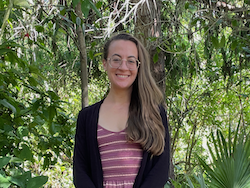Seraphina Solders

Neurosciences Graduate Student
ssolders@ucsd.edu
Ph.D. Candidate, Neurosciences Graduate Program (NGP), UC San Diego
M.S. Neurosciences, UC San Diego
B.A. Biology & Psychology, San Diego State University
Research Interests
My primary research interests involve structural brain changes in aging and how these changes may be impacted by the development of Alzheimer’s disease or traumatic brain injury (or the intersection of the two). I am particularly interested in exploring these topics with non-invasive measurement tools such as magnetic resonance imaging (MRI, especially diffusion MRI) and neuropsychological testing. The underlying goal driving my work is to better understand the factors that contribute to pathological aging in a way that allows us to detect risk-factors non-invasively and in-vivo, and intervene early on to improve the quality of life for our aging population.
Research Projects
My dissertation is focused on characterizing the human locus coeruleus, a brainstem nucleus implicated in the pathogenesis of Alzheimer’s disease, using recent advances in neuroimaging acquisition schemes and image processing techniques from CSCI. I am working to identify differential patterns of structural brain changes among cognitively normal older adults as well as those with mild cognitive impairment (MCI) and Alzheimer’s disease. To accomplish this, I am using two MRI modalities. The first is a T1 anatomical scan sensitized to neuromelanin, a pigment that occurs in large quantities in the LC, which I’m using to calculate a measure of assumed LC integrity. The second is diffusion MRI, which I am using to reconstruct white matter pathways projecting from the LC to other cortical areas. My goal is to examine structural characteristics both within the LC and also throughout its white matter connections, how these characteristics differ along the aging-MCI-Alzheimer’s continuum, and determine how they relate to other markers of Alzheimer’s disease pathology.
Outside of Lab:
Outside of lab, I am involved in various extracurricular activities. I am the chair of the NGP Peer Advising Committee’s Success Through Failure panel, where I organize and moderate a discussion between faculty and students on hardships and setbacks in an academic science career, and how to persevere. I volunteer and maintain materials for the NGP Outreach Program, in which we take neuroscience modules to classrooms around San Diego to teach young students about the brain. I am a writer and editor for NeuWrite San Diego, a neuroscience blog geared for the general public (see my writing here: neuwritesd.org). Finally, I am the San Diego City Coordinator for the tasteofscience festival (tasteofscience.org), which brings scientists out into the local community in casual settings to discuss their work with the public. I strongly value open communication both within academia about work-life balance and mental health, as well as between academics and non-academics to make science more accessible to everyone. When I’m not working, you can find me at the San Diego Zoo or Botanical Garden, fermenting things in my kitchen, or watching Star Trek.
